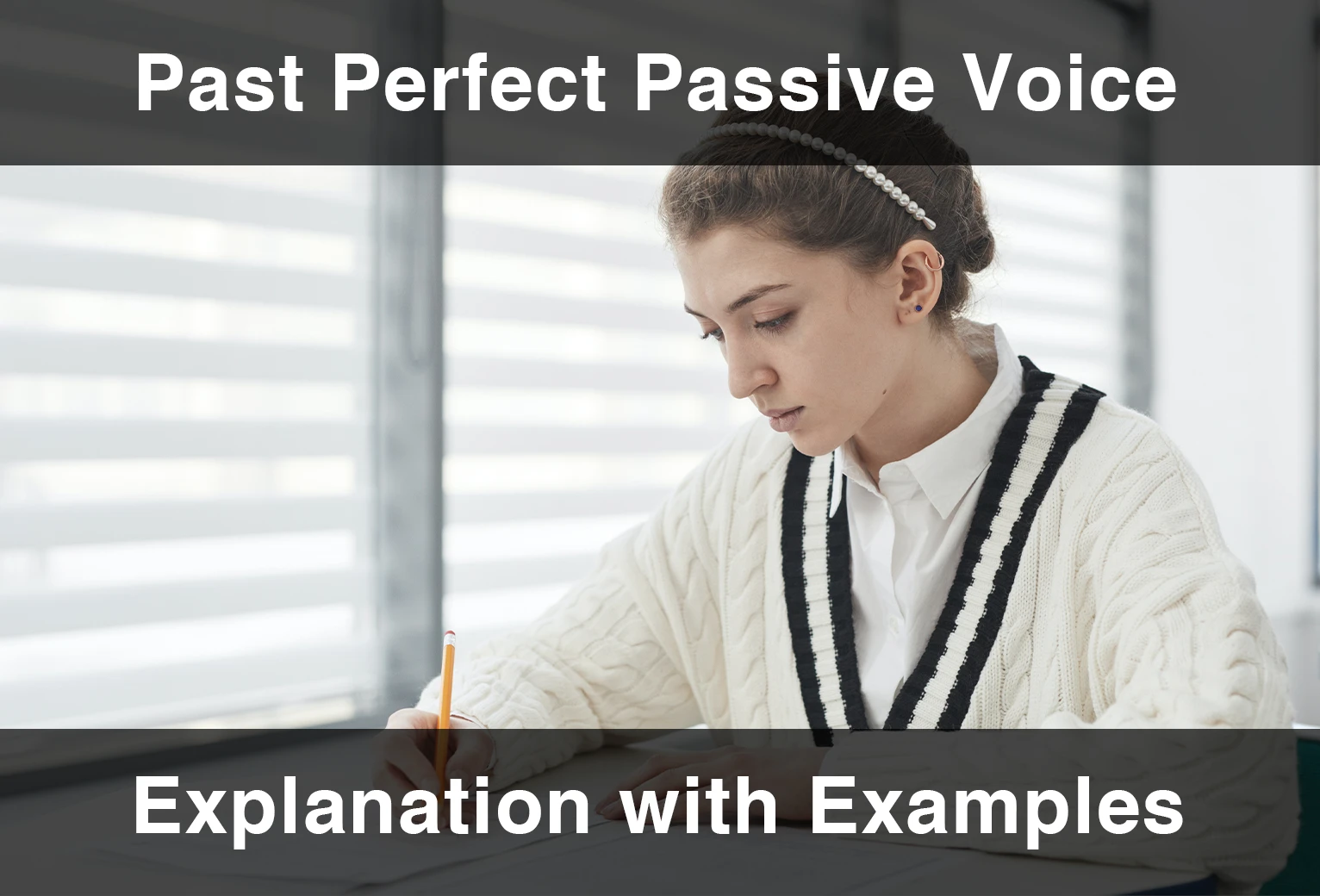Past Perfect Continuous Tense is used to refer to an action that started in the past and continued up until another time in the past. When using this tense, we put emphasis on both the duration and the completion of the action in question. We use passive voice in past perfect continuous tense to show that the subject of the sentence is acted upon.
How to Make Past Perfect Continuous Passive Sentences
Past Perfect Continuous Tense is used to refer to an action that started in the past and continued up until another time in the past. The past perfect continuous passive occurs most often in sentences that express actions that continued for a duration of time in the past and actions that caused other actions in the past. Generally, we use the passive voice when the focus is on the action and not on the performer of the action.
Past Perfect Continuous Tense Positive Passive Sentences
To form a positive sentence in Past Perfect Continuous Tense Passive Voice, we use the following rules:
We convert the object of the Active Voice Sentence into the subject of the Passive Voice Sentence.
We use the helping verb “had been” according to the subject of the Passive Voice Sentence.
We add “being”.
We use the past participle form of the Verb.
Then we use the word “by”, to show the doer.
Then we convert the subject of the Active Voice sentence into the object of the Passive Voice sentence.
In the end, add the remaining words if there are any.
The structure formula is:
Object + Had + Been + Being + past participle of main verb + by + Subject of Active Sentence
| Object | Auxiliary Verb (have + be) | Be | Main Verb | By + Subject |
|---|---|---|---|---|
| Object | Had been | Being | Past participle of the verb (V3) | I |
| Object | Had been | Being | Past participle of the verb (V3) | You |
| Object | Had been | Being | Past participle of the verb (V3) | We |
| Object | Had been | Being | Past participle of the verb (V3) | They |
| Object | Had been | Being | Past participle of the verb (V3) | He |
| Object | Had been | Being | Past participle of the verb (V3) | She |
| Object | Had been | Being | Past participle of the verb (V3) | It |
Active voice: He (Subject) + had + been + finishing (V3) + that exam (Object).
Passive voice: That exam (Object) + had been (Auxiliary verb) + being + finished (V3) + by him (By + subject).
Past Perfect Continuous Positive Passive Sentences Examples:
Here are some positive sentence examples in Past Perfect Continuous Tense Passive voice.
Active voice: He had been joining that party.
Passive voice: That party had been being joined by him.
Active voice: I had been helping Jim a lot .
Passive voice: Jim had been being helped a lot (by me).
Active voice: She had been buying two apples.
Passive voice: Two apples had been being bought by her.
Active voice: He had been writing this poem.
Passive voice: The poem had been being written by him.
Active voice: The teacher had been reading the book.
Passive voice: The book had been being read by the teacher.
Active voice: I had been preparing pizza for everyone in the house.
Passive voice: Pizza had been being prepared for everyone in the house (by me).
Active voice: Luke had been buying a bike.
Passive voice: A bike had been being bought (by Luka).
Past Perfect Continuous Tense Negative Passive Sentences
To form a negative sentence in Past Perfect Continuous Tense Passive Voice, we use the following rules:
We convert the object of the Active Voice Sentence into the subject of the Passive Voice Sentence.
We use the helping verb “had not been” to make the sentence negative.
We add “being”.
We use the past participle form of the Verb.
Then we use the word “by”, to show the doer.
Then we convert the subject of the Active Voice sentence into the object of the Passive Voice sentence.
In the end, add the remaining words if there are any.
The structure formula is:
Object + Had + Not + Been + Being + past participle of main verb + by + Subject of Active Sentence
| Object | Auxiliary Verb (have + not + be) | Be | Main Verb | By + Subject |
|---|---|---|---|---|
| Object | Had not been | Being | Past participle of the verb (V3) | I |
| Object | Had not been | Being | Past participle of the verb (V3) | You |
| Object | Had not been | Being | Past participle of the verb (V3) | We |
| Object | Had not been | Being | Past participle of the verb (V3) | They |
| Object | Had not been | Being | Past participle of the verb (V3) | He |
| Object | Had not been | Being | Past participle of the verb (V3) | She |
| Object | Had not been | Being | Past participle of the verb (V3) | It |
Active voice: He (Subject) + had + not + been + finishing (V3) + that exam (Object).
Passive voice: That exam (Object) + had + not + been (Auxiliary verb) + being + finished (V3) + by him (By + subject).
Past Perfect Continuous Negative Passive Sentences Examples:
Here are some negative sentence examples in Past Perfect Continuous Tense Passive voice.
Active voice: He had not been joining that party.
Passive voice: That party had not been being joined by him.
Active voice: I had not been helping Jim a lot .
Passive voice: Jim had not been being helped a lot (by me).
Active voice: She had not been buying two apples.
Passive voice: Two apples had not been being bought by her.
Active voice: He had not been writing this poem.
Passive voice: The poem had not been being written by him.
Active voice: The teacher had not been reading the book.
Passive voice: The book had not been being read by the teacher.
Active voice: I had not been preparing pizza for everyone in the house.
Passive voice: Pizza had not been being prepared for everyone in the house (by me).
Active voice: Luke had not been buying a bike.
Passive voice: A bike had not been being bought (by Luka).
Passive Questions in Past Perfect Continuous Tense Passive
To form passive questions in past perfect continuous tense, we can follow these steps:
We use the helping verb “had” to start the sentence.
We convert the object of the Active Voice Sentence into the subject of the Passive Voice Sentence.
We use “been” after that.
We then add “being”.
We use the past participle form of the Verb.
Then we use the word “by”, to show the doer.
Then we convert the subject of the Active Voice sentence into the object of the Passive Voice sentence.
In the end, add the remaining words if there are any.
At last, we use the sign of interrogation “?”.
For example:
Active: Had she been watching that show all night?
Passive: Had that show been being watched by her?
| Auxiliary Verb (have) | Object | Be | Be | Main Verb | By + Subject |
|---|---|---|---|---|---|
| Had | Object | Been | Being | Past participle of the verb (V3) | I |
| Had | Object | Been | Being | Past participle of the verb (V3) | You |
| Had | Object | Been | Being | Past participle of the verb (V3) | We |
| Had | Object | Been | Being | Past participle of the verb (V3) | They |
| Had | Object | Been | Being | Past participle of the verb (V3) | He |
| Had | Object | Been | Being | Past participle of the verb (V3) | She |
| Had | Object | Been | Being | Past participle of the verb (V3) | It |
Past Perfect Continuous Tense Passive Interrogative Examples:
Active voice: Had he been joining that party ?
Passive voice: Had that party been being joined by him ?
Active voice: Had I been helping Jim a lot ?
Passive voice: Had Jim been being helped a lot (by me) ?
Active voice: Had she been buying two apples.
Passive voice: Had two apples been being bought by her?
Active voice: Had he been writing this poem?
Passive voice: Had the poem been being written by him?
Active voice: Had the teacher been reading the book?
Passive voice: Had the book been being read by the teacher?
Active voice: Had I been preparing pizza for everyone in the house?
Passive voice: Had pizza been being prepared for everyone in the house (by me)?
Active voice: Had Luke been buying a bike ?
Passive voice: Had a bike been being bought (by Luka) ?
Negative Passive Interrogative Sentences in Past Perfect Continuous Tense
To form passive questions in past perfect continuous tense, we can follow these steps:
To form passive questions in past perfect continuous tense, we can follow these steps:
We use the helping verb “had” to start the sentence.
Then we use the word “not”, to make the sentence negative.
We convert the object of the Active Voice Sentence into the subject of the Passive Voice Sentence.
We use “been” after that.
We then add “being”.
We use the past participle form of the Verb.
Then we use the word “by”, to show the doer.
Then we convert the subject of the Active Voice sentence into the object of the Passive Voice sentence.
In the end, add the remaining words if there are any.
At last, we use the sign of interrogation “?”.
For example:
Active: Hadn’t she been watching that show all night?
Passive: Hadn’t that show been being watched by her?
| Auxiliary Verb (have) + not | Object | Be | Be | Main Verb | By + Subject |
|---|---|---|---|---|---|
| Hadn’t | Object | Been | Being | Past participle of the verb (V3) | I |
| Hadn’t | Object | Been | Being | Past participle of the verb (V3) | You |
| Hadn’t | Object | Been | Being | Past participle of the verb (V3) | We |
| Hadn’t | Object | Been | Being | Past participle of the verb (V3) | They |
| Hadn’t | Object | Been | Being | Past participle of the verb (V3) | He |
| Hadn’t | Object | Been | Being | Past participle of the verb (V3) | She |
| Hadn’t | Object | Been | Being | Past participle of the verb (V3) | It |
Past Perfect Continuous Tense Passive Interrogative Examples:
Active voice: Hadn’t he been joining that party ?
Passive voice: Hadn’t that party been being joined by him ?
Active voice: Hadn’t I been helping Jim a lot ?
Passive voice: Hadn’t Jim been being helped a lot (by me) ?
Active voice: Hadn’t she been buying two apples.
Passive voice: Hadn’t two apples been being bought by her?
Active voice: Hadn’t he been writing this poem?
Passive voice: Hadn’t the poem been being written by him?
Active voice: Hadn’t the teacher been reading the book?
Passive voice: Hadn’t the book been being read by the teacher?
Active voice: Hadn’t I been preparing pizza for everyone in the house?
Passive voice: Hadn’t pizza been being prepared for everyone in the house (by me)?
Active voice: Hadn’t Luke been buying a bike ?
Passive voice: Hadn’t a bike been being bought (by Luka) ?
Short Answers in Past Perfect Continuous Tense Passive
To form short answers in past perfect continuous tense passive voice, we can follow these steps:
We use “yes” or “no” according to the question.
We use the needed subject.
We use had been being .
We use the past participle form of the verb.
Positive Answers:
| Confirmation Word | Subject | Have + be | Being |
|---|---|---|---|
| Yes, | I | Had been | Being |
| Yes, | You | Had been | Being |
| Yes, | We | Had been | Being |
| Yes, | They | Had been | Being |
| Yes, | He | Had been | Being |
| Yes, | She | Had been | Being |
| Yes, | It | Had been | Being |
Had a bike been being bought ? / Yes, it had.
Had an apple been being eaten ? / Yes, it had.
Had a ring been being ringed ? / Yes, it had.
Negative answers:
| Denial Word | Subject | Have + be | Being |
|---|---|---|---|
| No, | I | Had not been | Being |
| No, | You | Had not been | Being |
| No, | We | Had not been | Being |
| No, | They | Had not been | Being |
| No, | He | Had not been | Being |
| No, | She | Had not been | Being |
| No, | It | Had not been | Being |
Had a bike been being bought ? / No, it hadn’t.
Had an apple been being eaten ? / No, it hadn’t.
Had a ring been being ringed ? / No, it hadn’t.
Wh- Questions in Past Perfect Continuous Tense Passive
To ask for more specific information, we can include question words in our passive voice questions. These question words include “who, what, where, when, how etc.”. To ask a passive question in Past Perfect Continuous Tense with these question words, we need to follow this simple formula:
WH- questions + Subject + had + been + being + Main verb (V3) + by + object ?
| Question Word | Object | Have + be | Being | Verb | By + subject |
|---|---|---|---|---|---|
| Who, what, where, when, how | Object | Had been | Being | V3 | By + subject |
Here are some examples of Wh- question sentences in Past Perfect Continuous Tense Passive:
Where the wood had been being collected by her when the snow started ?
Why the apples had been being eaten ?
Where the treasures had been being hid?
Why the coal had been being burnt ?
How the cat had been being chased by them ?
Frequently Asked Questions About Past Perfect Continuous Tense Passive Voice
What are some examples of Past Perfect Continuous Passive Voice sentences?
Here are some examples for Past Perfect Continuous voice sentences:
The poem had been being written by him.
A bike had been being bought.
Jim had been being helped a lot.
What are some examples of negative Past Perfect Continuous Passive Voice sentences?
Here are some examples for negative Past Perfect Continuous Passive voice sentences:
The poem had not been being written by him.
A bike had not been being bought.
Jim had not been being helped a lot.
What are some examples of interrogative Past Perfect Continuous Passive Voice sentences?
Here are some examples for interrogative Past Perfect Continuous Passive voice sentences:
Had a bike been being bought ?
Had an apple been being eaten ?
Had a ring been being ringed ?
What is the difference between active voice and passive voice?
In an active voice, the subject is performing the action. It is always known who is doing the action. In a passive voice, the subject is the receiver of the action. It is not always clear who is doing the action. To give the information about the carrier of the action, we use the preposition “by” followed by the agent of the action.
Would you like to put what you have learned into practice? You can access everything you need to learn English on a single platform! With 25-minute one-on-one live English lessons, 40-minute group lessons, more than 30,000 interactive videos, vocabulary learning tools, AI-supported tutor MiMi, quizzes, and interactive activities, EnglishCentral offers its users a personalized and quality education plan at an affordable price. How about registering for EnglishCentral now and starting to learn English?











